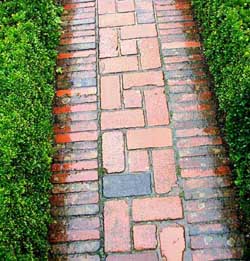 Living things in the
landscape are called softscape.
Hardscape consists of
all the non-living items in the garden such as paths,
decks, patios, sculptures,
containers, arbors, pergolas,
wall plaques, ironware, fences, garden sheds, etc.
Living things in the
landscape are called softscape.
Hardscape consists of
all the non-living items in the garden such as paths,
decks, patios, sculptures,
containers, arbors, pergolas,
wall plaques, ironware, fences, garden sheds, etc.
As in any garden design,
hardscape has a definite and wonderful place in the
hosta garden. To be most effective, the hardscape should
conform with the overall mood of the garden. Shade
gardens are almost all informal in nature. The shade is
usually provided by trees that nature spread randomly
around the problem in a woodlot. This is informal since
a formal arrangement would require that the trees be
evenly spaced in geometric forms and angles.
So, items such as paths,
patios, containers, decks, etc. used in the shade garden
should be predominately, informal. That is, they should
be made of natural materials and lean toward the colors
of nature and earth tones. One way of looking at
informal is that items in this category tend to be
closer to nature. They are not highly refined by human
intervention. Therefore, earth tone plain paving stones
would be more appropriate than highly glazed, bright
colored ceramic tiles.
Also, hostas tend to be
coarse textured plants and formal gardens lean more
toward the fine texture end of the scale. So, some of
the hardscape needs to be in the fine texture mode to
play off against the predominant coarse texture of the
hostas. This could be a slender, delicate sculpture or
ironwork of some sort.
Many hostas are also in a
rounded, mound form. To give some contrast, there needs
to be some upright, vertical forms sprinkled through the
garden. This too may be in the form of hardscape pieces
such as sculptures, ironwork, trellises, pergolas, etc.



